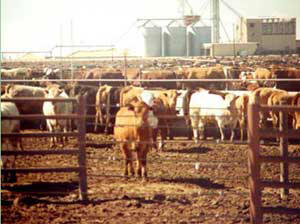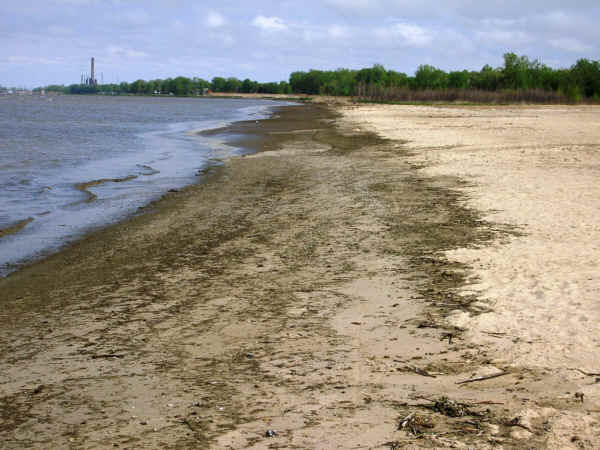Holy Cow! Vast Hike in Cattle, Factory Farms, May Be Causing Beach Muck
|
||||||||||
| Printer Friendly Story View |

"Factory farm" operations like this CAFO (confined animal feeding operation) are under scrutiny for causes of pollution and health problems.
Heroic efforts of a local committee to control beach muck and improve conditions for swimmers at Bay City State Park are being challenged by, well, herds of cows.
There is pretty strong evidence to indicate that the runoff of manure from these cows is contributing to the growth of algae and muck clogging Bay County beaches and causing a health hazard.
Critics point to so-called "factory farms," mainly in Huron County, as a major cause of the manure runoff that may be contributing to algae growth and muck.
The Michigan Department of Environmental Quality is bringing confined animal feeding operations (CAFOs) under rigorous permit requirements, an official told a Caseville group recently.
However, Michigan has very good quality drinking water and excels at testing water according to experts from Michigan State University and other states. Local officials report good water quality and testing is done regularly.
The Saginaw Bay Science Committee shocked the community May 2 when it presented results of recent testing and issued a health advisory warning of the dangers of muck along the bay shore.
A committee headed by County Commissioners Kim Coonan and Ernie Krygier, with assistance from County Financial Analyst Robert Redmond and volunteers from labor unions and other organizations, is working feverishly to clean the 1,200 foot long beach at State Park in time for the Memorial Day start of the camping and recreation season.

There is pretty strong evidence to indicate that the runoff of manure from these cows is contributing to the growth of algae and muck clogging Bay County beaches and causing a health hazard.
Last year the committee got approval from the U.S. Army Corps of Engineers and cleaned the beach, only to have muck form along the shoreline, deterring swimmers. The group then installed floating docks over the muck so swimmers could safely access the water.
The committee has plunged the profits from a recent "Beach Wellness" Run into purchase of an $18,000 beach grooming machine, a tractor and front end loader. Proceeds from the run and donations from private sources over the next four or five years will be used to amortize the equipment, said Redmond.
From 2000 to 2005 a veritable stampede of 29,200 extra cows boosted the herds in the five-county Saginaw Bay Coastal Area to a total of 155,500, about a 19 percent increase, according to a Saginaw Bay Coastal Initiative report. About 69 percent of these cattle, or 107,600, are in Huron County.
There were significant increases in both the number of cattle/calves (approximately 19%) and milk cows (approximately 45 percent), the Saginaw Bay Coastal Initiative has reported. During the same time period there was a slight decrease in the number of hogs & pigs(approximately 7%).
Arenac County had 8,600 cows, Bay 5,500, Saginaw 11,500, and Tuscola 22,300, according to the report.
Huron had about 77 percent, or 62,000, of the 81,000 hogs and pigs in the five county region. There were 1,400 in Arenac, 1,400 in Bay, 6,000 in Saginaw and 11,000 in Tuscola.
All those animals produce lots and lots of, you know, manure. And what happens to some of the manure? It washes into drainage ditches and ends up in Saginaw Bay.
Other sources of nutrient contamination in the bay include industrial and municipal discharge, combined sewer overflows, failing septic systems, urban and agricultural runoff, atmospheric deposition, contaminated sediments and old waste disposal sites, according to Juli Dyble, biologist with the National Oceanic and Atmospheric Administration.
Ms. Dyble met last year with Caseville residents to discuss the algae and shoreline muck. The Huron Daily Tribune reported that Ms. Dyble said the introduction of zebra mussels into the Great Lakes results in algae blooms because the mussels filter the water, allowing more sunlight to penetrate and contribute to algae growth.
She recommended reducing fertilizer use, maintaining septic systems, using low phosphorous detergents and encouraging wetland restoration and vegetative buffer strips.
Stanley Pruss, deputy director of the Michigan Department of Environmental Quality, told the Caseville group a study has found agricultural and pasture run-off is the biggest source of nutrient contamination in Minnesota.
Some of the animals in the region are in what have become known as "factory farms," or CAFOs, (confined animal feeding operations). Thousands of animals are raised on plots of land that would traditionally be considered far too small, according to an environmental activist website (http://www.factoryfarm.org/ teenguide/2.html.)
The manure and urine and water used to flush the confinement buildings is put into lagoons until the effluent can be applied to the land as fertilizer. The lagoons leak and pollute streams and groundwater, and create air pollution and odors. Harmful bacteria, called pathogens, from leaking lagoons can cause disease in humans. The hormones and antibiotics that are fed to the animals may also get into streams and groundwater and cause health problems.
According to experts, the result of the farm feeding operations and increased cattle in the region is "an increase in the potential impact of animal production on the water quality of Saginaw Bay."
In a meeting at the Double Tree Hotel attended by about 200 persons, the Bay County Health Department and the Huron County Health Department announced an advisory on the recent and excessive algal growth, detritus or "muck," which has covered the shoreline in parts of the Great Lakes, including Saginaw Bay.
Perceptions of increases in muck formation and sediment along the beaches in Bay and Huron Counties has resulted in great concern among the public, especially local homeowners.
"Preliminary testing of the material has detected fecal indicators, including E. coli, which also has resulted in public concerns related to the potential human health implications of contact with the materials," the health advisory stated.
The Health Departments of Bay and Huron Counties advised that until the exact nature of the debris (muck) that is causing concern is identified, persons should limit their contact with the debris and wash with soap and water if in contact with the debris. People with open sores and wounds and anyone that may ingest the material should avoid the "muck" areas altogether. The local health departments from Bay, Huron and Tuscola participated on the Saginaw Bay Science Committee which is looking at the Saginaw Bay "muck" issue.
For more information on the Saginaw Bay Science Committee or recreational water illnesses, please visit the Bay County website at www.baycounty-mi.gov, the Huron County Health Department website at www.huron.localhealth.net or the Tuscola County Health Department's website at www.tchd.us.
Meanwhile, Dr Joan B. Rose of Michigan State University updated frustrated cottage owners on the state's efforts to find a safe way to rid their beaches of the black beach muck, the residue from the algae blooms that rise up from the lake bottom in the summer.
"Since as everyone can smell, it contains fecal matter, it poses a health risk," she said in a talk in Lansing entitled "Our Water, Hour Health, Our Michigan." Therefore, the state and MSU are trying to develop a way for residents to safely dispose of this nuisance without further risk of illness or contamination.
Dr. Rose holds the Homer Nowlin Chair in Water Research at Michigan State University and is an international expert in water microbiology, water quality and public health safety and has published more than 250 manuscripts on those topics. She is one of the foremost experts in the world on water quality, particularly the cryptosporidium that can spread through drinking water. Norovirus, Algae blooms, black beach muck, noxious overflow, agricultural waste and mixed use beaches where people recreate and drink the water all challenge Michigan's health and environment.
Environmentalists urge consumers to eat "sustainable" meat, vegetables and fruit that comes from independent farms that use traditional methods. ###
| Printer Friendly Story View |
|
|

Dave Rogers |
|
|
|
Printer-Friendly Story View
0200 Nd: 04-21-2024 d 4 cpr 0
12/31/2020 P3v3-0200-Ad.cfm
SPONSORED LINKS
12/31/2020 drop ads P3v3-0200-Ad.cfm


